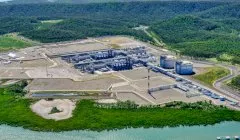Invest
What would it cost to stop global warming?
To stop the impact of global warming and reduce net carbon emissions to zero by 2050, the world would need to spend $73.8 trillion, new research has found.
What would it cost to stop global warming?
To stop the impact of global warming and reduce net carbon emissions to zero by 2050, the world would need to spend $73.8 trillion, new research has found.

According to Morgan Stanley analytics, there are five key areas in which this money would need to be spent the world over in order to achieve the Paris Accord’s target impact limit of 1.5 degrees.
Renewables – Including renewable power generation, storage and grids will cost $20.55 trillion to update the existing power systems and enable deliverance of around 80 per cent of global power by 2050.
The report said that as the price of energy becomes more affordable, it predicts solar will become the fastest-growing renewable technology.
Electric vehicles – With just 5 million battery electric vehicles (EVs) sold last year, the market is still lagging behind.

“Increasingly, strict regulation and new products are driving electric vehicle (EV) penetration across Europe and China. [We] estimate $16.09 trillion capital investment in EVs and related infrastructure over the next 30 years,” Morgan Stanley said.
Carbon capture and storage (CCS) – While CCS might be less common, it is needed to offset the carbon emissions of coal and gas–powered plants. At a cost of $3.6 billion by 2050, it is one of the cheaper options.
“With over 200,000 megawatts of new coal-fired generation capacity, [plants are] currently under construction globally and CCS is the only option to decarbonise these plants,” the report continued.
Hydrogen – Hydrogen – or more specifically, clean hydrogen produced by renewables or CCS power – could be the next big energy source.
At a cost of $7.9 trillion, investment is reportedly needed in electrolysers as a source of renewable energy. In addition, significant investment in renewable power generation capacity would be required to ensure the hydrogen produced is green.
Morgan Stanley estimated that this would require $19.01 trillion of investment in new capacity by 2050 (or $584.91 billion a year).
“Clean hydrogen offers a material opportunity to reduce carbon emissions in industry, which so far has struggled to find clean alternatives to many of the processes needed in steel and cement, for example,” Morgan Stanley said.
Biofuel – Clean hydrogen is not the only fuel crucial for our transferral into a net zero carbon world. Biofuels are made from food crop, waste agricultural feed and algae, which all provide a clean source of energy for aviation.
Biofuel for aviation and trucks will cost $3.95 trillion. This second-generation ethanol bio refinery will have the capacity to produce 30 million litres of fuel-grade ethanol per year.
“Biofuels will be an effective transition fuel for light road vehicles over the coming decades to reduce the carbon intensity of the remaining combustion engines,” Morgan Stanley said.
Opportunity for investors
Opposition leader Anthony Albanese stated during the Centre of Economic Development in Perth that climate policy will be part of the new industrial revolution, creating a manufacturing boom and unlocking new jobs and export opportunities.
“The world is decarbonising. With the right planning and vision, Australia cannot only continue to be an energy-exporting superpower, we can also enjoy a new manufacturing boom. This means jobs,” Mr Albanese said.
Cost of inaction
On the other hand, inaction will will cost the world $14.62 trillion to $29.24 trillion in GDP by 2100, according to the report.
“Various academic studies on the effects of climate change have tried to quantify the impact that climate change can have on economies. These studies have utilised multiple approaches, and a survey of the recent literature suggests that the economic losses due to climate change can affect anywhere between 3 and 7 per cent of global GDP over the long term,” the report concluded.
About the author

About the author


Commodity
Gold's remarkable surge in 2025 sets the stage for a volatile 2026
Gold has experienced a stellar year in 2025, achieving over 50 all-time highs and delivering a return exceeding 60%, making it one of the top-performing assets. This impressive performance has been ...Read more

Commodity
Scenic Eclipse launches fifth Antarctica season with new submersible, private jet transfers and helicopter experiences
Scenic Discovery Yachts has commenced its fifth Antarctica season, introducing new ultra-luxury experiences including private jet transfers, advanced helicopter excursions and a new Scenic Neptune ...Read more

Commodity
Is crypto getting the shaft for a big gold re-polish?
While the spotlight shines on trendy cryptocurrencies, investors evidently haven’t lost interest in traditional and tangible commodities like precious metals. Read more

Commodity
Morrison’s gas-led recovery sees manufacturers ‘held to ransom’ by gas cartel
Australia’s manufacturing sector and its workers are being ‘held to ransom’ by the gas cartel, despite the Morrison government promising cheap gas as a key policy in the COVID-19 recovery planRead more

Commodity
‘Investors should take note’: Gas-led recovery to lead to stranded assets
Australia’s gas-led economic recovery could be relying on inaccurate financial assumptions, new research has revealed. Read more

Commodity
Credibility up in flames as government opens 21 new gas and oil exploration sites
Climate groups are saying the Morrison government lacks any credibility when it comes to climate change after it announced 21 new gas and oil exploration areas. Read more

Commodity
Morrison urged to drop gas-led recovery after new global warning
The International Energy Agency has found that countries like Australia need to transition their energy grid within 14 years to reach net zero, defying Prime Minister Scott Morrison’s gas-led economic ...Read more

Commodity
Taxpayers to bear brunt of Morrison’s $2bn pledge to oil refineries
Taxpayers are set to be on the hook for up to $2 billion over the next decade as the government commits to protecting two oil refineries. Read more

Commodity
Gold's remarkable surge in 2025 sets the stage for a volatile 2026
Gold has experienced a stellar year in 2025, achieving over 50 all-time highs and delivering a return exceeding 60%, making it one of the top-performing assets. This impressive performance has been ...Read more

Commodity
Scenic Eclipse launches fifth Antarctica season with new submersible, private jet transfers and helicopter experiences
Scenic Discovery Yachts has commenced its fifth Antarctica season, introducing new ultra-luxury experiences including private jet transfers, advanced helicopter excursions and a new Scenic Neptune ...Read more

Commodity
Is crypto getting the shaft for a big gold re-polish?
While the spotlight shines on trendy cryptocurrencies, investors evidently haven’t lost interest in traditional and tangible commodities like precious metals. Read more

Commodity
Morrison’s gas-led recovery sees manufacturers ‘held to ransom’ by gas cartel
Australia’s manufacturing sector and its workers are being ‘held to ransom’ by the gas cartel, despite the Morrison government promising cheap gas as a key policy in the COVID-19 recovery planRead more

Commodity
‘Investors should take note’: Gas-led recovery to lead to stranded assets
Australia’s gas-led economic recovery could be relying on inaccurate financial assumptions, new research has revealed. Read more

Commodity
Credibility up in flames as government opens 21 new gas and oil exploration sites
Climate groups are saying the Morrison government lacks any credibility when it comes to climate change after it announced 21 new gas and oil exploration areas. Read more

Commodity
Morrison urged to drop gas-led recovery after new global warning
The International Energy Agency has found that countries like Australia need to transition their energy grid within 14 years to reach net zero, defying Prime Minister Scott Morrison’s gas-led economic ...Read more

Commodity
Taxpayers to bear brunt of Morrison’s $2bn pledge to oil refineries
Taxpayers are set to be on the hook for up to $2 billion over the next decade as the government commits to protecting two oil refineries. Read more









